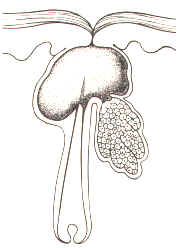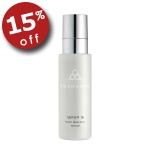Comedones
The first blemish to form as acne begins to appear is called a “comedone,” and it is critical to all the blemishes that eventually develop. A comedone is a plug that forms within the pilosebaceous duct. It is made up of dead cells from the lining of the duct that are mixed with sebum produced by the oil gland

There are two types of comedones. The open comedone, more familiarly called a blackhead, is visible on the skin because the plug has formed in the surface opening of the duct

Blackheads are not black because of dirt; they take their color from the normal skin pigment that is within the dead cells. The other type of comedone, the closed comedone or whitehead, is a similar plug within the duct, but it is located deeper, underneath the skin’s surface

Closed comedones appear as small, pale elevations, without any obvious openings.
Blackheads can usually be eliminated by gentle squeezing; whiteheads are difficult to remove, requiring a puncture to open them and considerable pressure to push out their contents. (The pros and cons of attempting to remove comedones is discussed in detail in later chapters.) Black-heads are unsightly, but it is the closed comedone that is responsible for other blemishes that may develop.
Papules
The word papule is synonymous with the word pimple. Papules are firm, red swellings of various sizes that appear on normal skin as another manifestation of acne. Actually, most papules develop at the site of closed comedones, but the comedone may be so tiny that it can be seen only with a microscope. Sometimes papules are tender to the touch, but more often they are not. Squeezing will not eliminate
a papule because it is solid and there is nothing to squeeze out. In fact, vigorous squeezing may injure the skin, increase inflammation in the area, and actually enlarge the papule. The best “first aid” treatments for papules are warm compresses and drying creams or lotions.
Pustules
Pustules are small abscesses on the skin. They are soft pimples filled with pus, which is made up of white blood cells. Pustules can be on the surface of the skin or deep within it. Those that are superficial break easily, either by themselves or by the process of washing, and they disappear quickly, within three or four days. Deeper pustules, indicating a more severe form of acne, are not easily broken and should not be squeezed. Very large and deep pustules sometimes have to be incised and drained by a dermatologist in order to prevent scarring.
Acne Cysts
Acne cysts are large areas of inflammation deep within the skin. Sometimes they are formed by two or more adjacent blemishes coming together to form a single, red, tender swelling. They are often filled with a thick, creamy fluid made up of pus, dead cells, and sebum. Acne cysts are responsible for most of the scarring associated with severe acne and consequently require professional attention.
Macules
After acne blemishes subside, flat, reddened areas frequently remain on the skin. These macules represent the end stage of the inflammatory process. Unfortunately, they add to the cosmetic problem and may persist for a long time, sometimes for months.
Hyperpigmentation
An increase in the brown skin pigment called melanin sometimes remains after acne blemishes have healed, as it often does in other forms of inflammation, such as sunburn. Like red macules, such hyperpigmentation is not permanent, although it may be months before it fades away. Bleaching creams are available but are not reliable and are best reserved for the rare situation in which the hyperpigmentation fails to disappear spontaneously.
Scars
Scars are permanent alterations in the normal structure of the skin. Many people with cystic acne develop scars because of the destruction of connective tissue in the deeper layers of skin. More surprising is the fact that some people with relatively superficial acne blemishes also develop scars. Thus, scarring seems to be an individual response to inflammation and tissue damage. Furthermore, the type of scar that forms can vary from person to person. One of the most obvious kinds of scar is called a keloid. This is a large, pink, often oddly shaped mound of thick scar tissue that forms at the site of the injury and subsequent healing. Strangely, the amount of scar tissue in keloids is not always proportionate to the severity of the acne, and seemingly minor blemishes may lead to large keloids. Keloids most often occur on the chest and back and less frequently on the face, jaw, or forehead.
Another common scar that can follow acne inflammation is called an “ice pick” scar. As the name implies, this is a deep, pointlike depression, as if a sharp object had been driven into the skin. Other scars may appear where skin tissue has been lost; these form depressed areas, as if a portion of the skin had been scooped out.
You should not assume that everyone who experiences acne will have all these different blemishes. It is not uncommon to have mostly one type and a scattering of some of the others. You might have comedone acne, in which the outbreak is almost entirely made up of blackheads and closed comedones; pustular acne, in which all the blemishes are pus pimples; or cystic acne, in which deep cysts predominate. Which treatment is best depends on the nature of the predominant blemish as well as on the overall severity of the problem.
Although all the varieties of acne have features in common, several unusual and distinctive forms of acne can be separated from the common adolescent types. These conditions affect disparate age groups the very young and the adult.
|







 Today's random forum topics
Today's random forum topics
 What our customers are saying
What our customers are saying